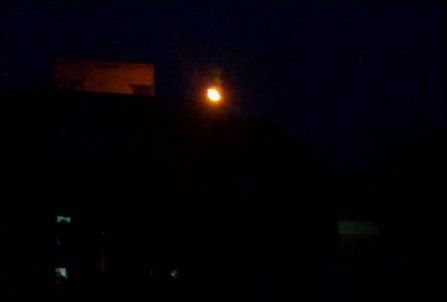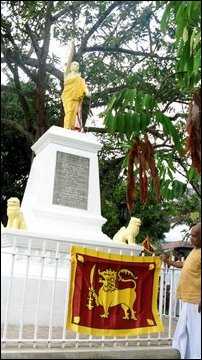 [TamilNet, Wednesday, 30 November 2011, 06:38 GMT]
[TamilNet, Wednesday, 30 November 2011, 06:38 GMT]A single event that took place in the University of Jaffna on the Heroes Day, Sunday, has captivated the minds of Tamils all over the world, more than the diaspora functions marked by ever increasing participation of people but in some instances showed hijack aimed at dividing, capturing and ‘softening’ the struggle by the very forces against whom the spirit of the Day was meant for. Amidst all the oppression against the Day, by genocidal Sri Lanka backed by imperialism especially the Indian one, unidentified people lit the Heroes Day flame atop a tall building in the Jaffna University to shine like the star of hope. The Sinhala brethren should understand the event in the same vein of they take pride in Sri Sumangala hoisting the lion flag in Dalada Maligawa even after the British conquest of Kandy, an academic in Jaffna said.
Further comments from the academic in Jaffna:
Wariyapola Sri Sumangala Thera, the Anunayaka (deputy chief) of the Asgiriya Chapter of Buddhist monks, removed the Union Jack hoisted by a British soldier at the Paththiruppuwa (the octagonal pavilion) of the Dalada Maligawa in 1815 and re-raised the lion flag of the Kandyan state, even though there was a military conquest and the king was captured.
The Kandyan Convention between the British and the chieftains of Kandy was being discussed at the time, and Sri Sumangala insisted to the military conquerors that unless the convention was signed deciding on the transfer of sovereignty, Union Jack could not replace the Lion Flag.
Three years later, when a rebellion took place in Kandy against the British rule, Sri Sumangala removed the Tooth Relic of Buddha (regarded by the Sinhalese as the possession of which gives the right to any one to rule over them) from Dalada Maligawa, went into hiding, and later handed it over to the chieftain, Keppetipola Disawe, who was leading the rebellion.
The British captured the relic and Sri Sumangala in 1818, and after convicted for ‘treason’, Sumangala was imprisoned in Jaffna.
British imperialism eventually bowing down from the island and hoisting the lion flag at Paththiruppuwa becoming an annual ritual ever since the independence of Sinhalese are matters of history.
The Kandyan Convention never satisfied the Sinhalese.
Rather than remembering the Kandyan Convention, an elite decision to collaborate with the conquerors, today’s Sinhalese take pride only in the resistance shown by Sri Sumangala.
If the Sinhalese could apply their sentiments in an enlightened way in understanding the Eezham Tamils – their sibling nation for centuries in the island – they could see why the Eezham Tamils have to regain their sovereignty by struggling against agent-imperialists in Colombo backed by imperialists.
Bringing in foxes, apes and donkeys to replace the tigers and showing those as leaders willing to collaborate, is the age-old tactic of imperialism re-enacted in the case of Eezham Tamils. But as history shows, that will not last long.
If the Sinhala masses and their elite think that they have a ‘common history’ for Sinhalese and Eezham Tamils in the island, then rather than being carried away by the agent-imperialists, they should help restoring the sovereignty of Eezham Tamils for peaceful co-existence and for partnership in facing the threats of imperialism in the island.
If they don’t see it, then they only concede that ‘history is different’ to Eezham Tamils and Sinhalese, and thus everything else too are different.


